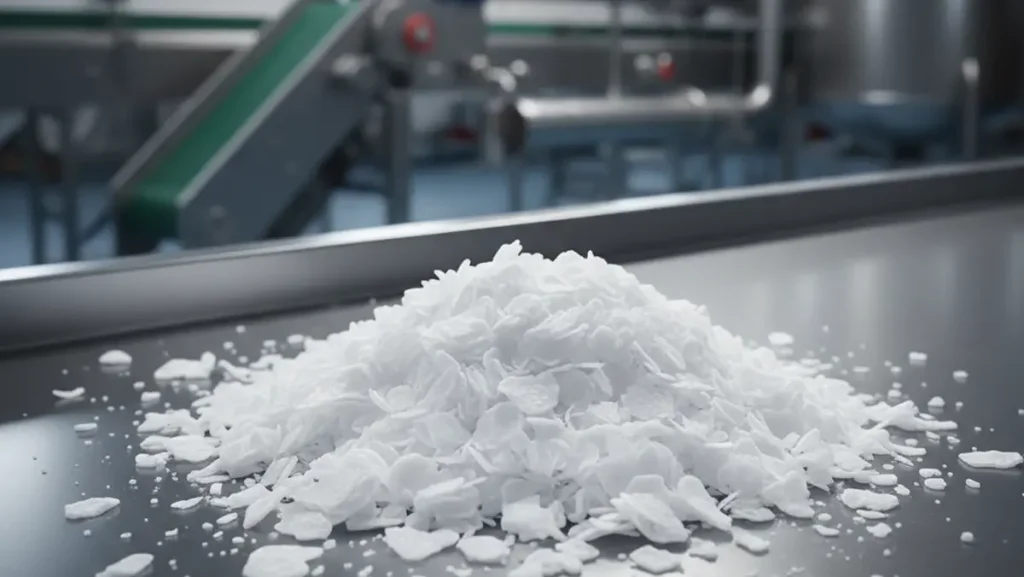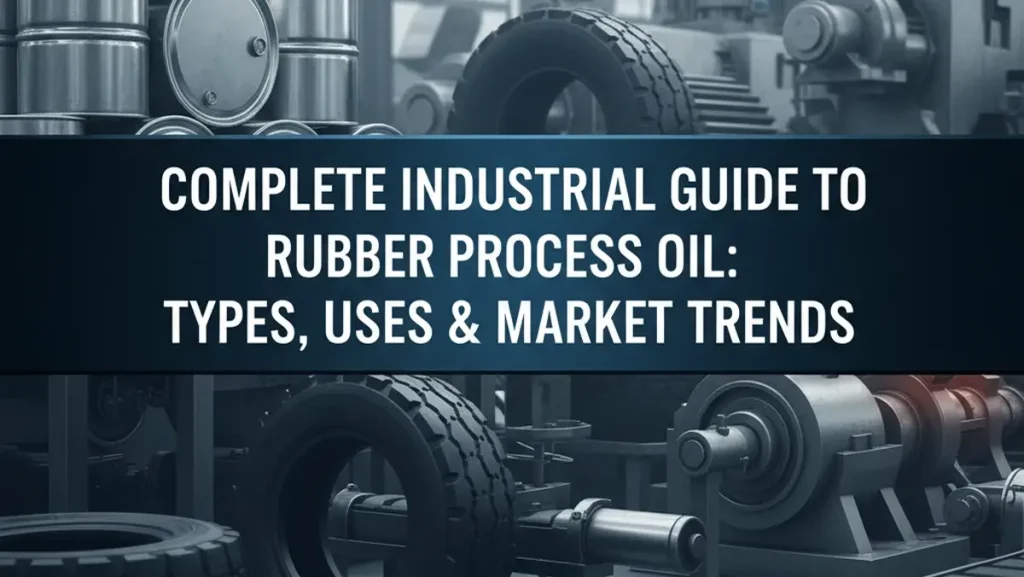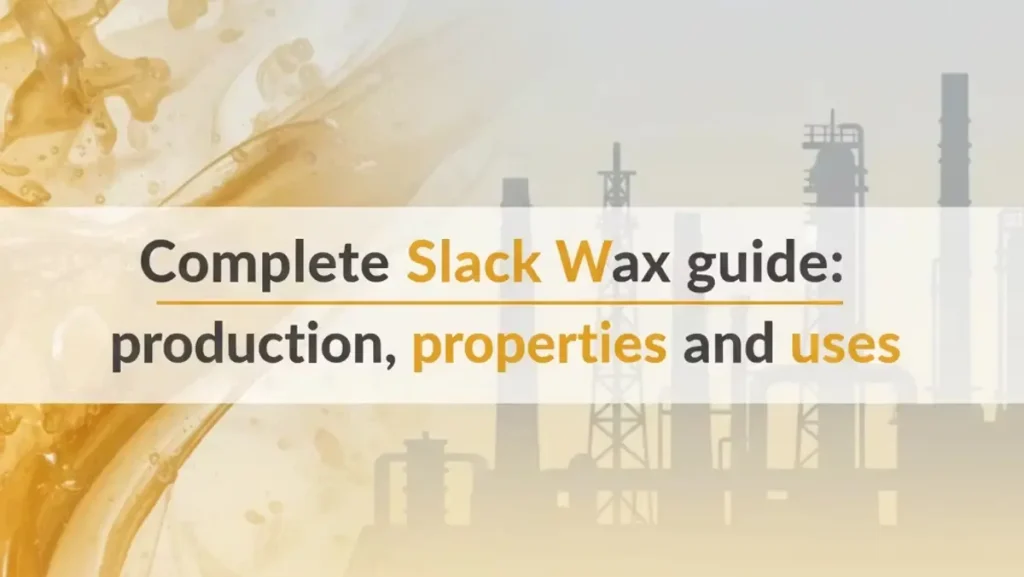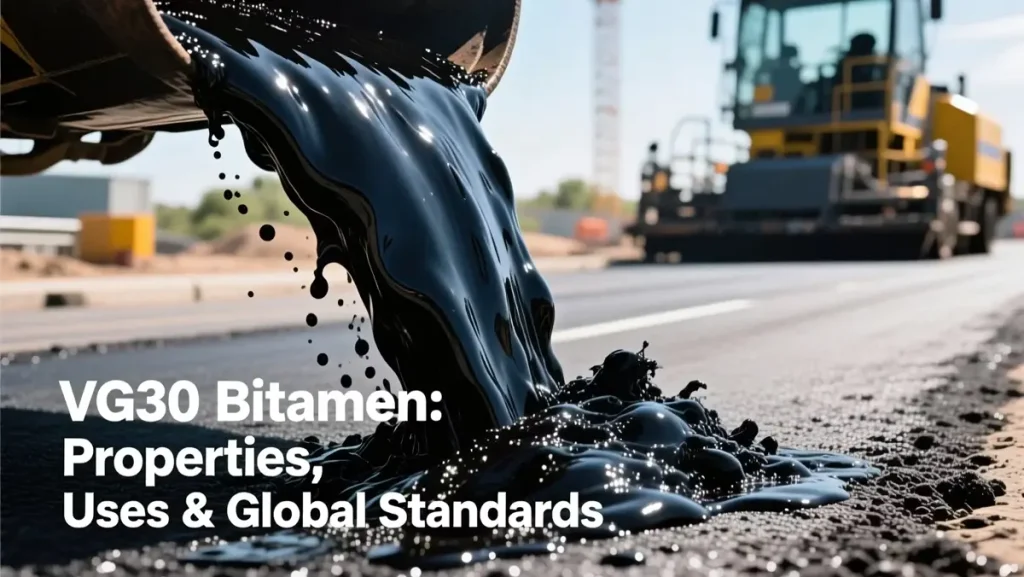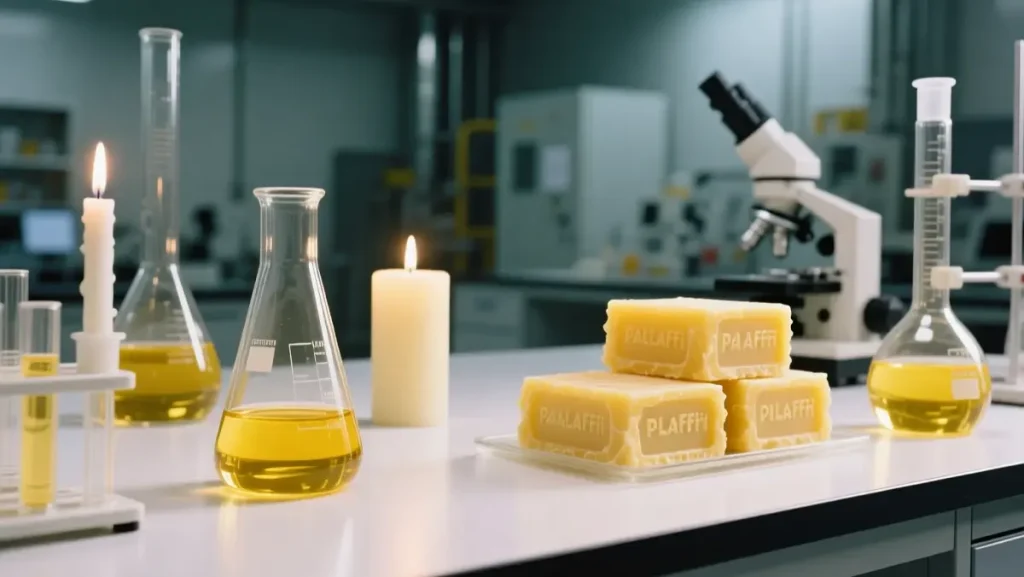Caustic soda flakes are one of the most important basic chemicals used in today’s industries. They are the solid form of sodium hydroxide (NaOH), which plays a vital role in manufacturing detergents, textiles, paper, alumina, and many other products. The importance of caustic soda flakes lies in their high purity, easy handling, and strong reactivity, making them essential for both large‑scale industrial operations and laboratory applications.
In chemical trade markets, caustic soda flakes are valued for their stability and wide usability. Their demand keeps increasing, especially in Asia Pacific and the Middle East, where refining, water treatment, and chemical sectors continue to grow. Understanding their composition, production process, and safe handling helps industries maintain efficiency and global standard compliance.
Definition and Overview
Caustic soda flakes are the solid, flaky form of sodium hydroxide (NaOH)—a highly corrosive, inorganic compound crucial in many production processes like cleaning, refining, or chemical synthesis.
- Chemical formula: NaOH
- Physical form: White opaque flakes or crystals, odorless, dissolve easily in water (exothermic reaction).
- Common names: Caustic soda, lye, sodium hydrate, white caustic, ascarite.
Core Physical Properties
| Property | Value |
|---|---|
| Appearance | White opaque crystals or flakes |
| Density | 2.13 g/cm³ (anhydrous) |
| Melting Point | 318–323 °C |
| Boiling Point | 1 388 °C |
| Water Solubility | 418 g/L (0 °C) → 1 000 g/L (25 °C) |
| Corrosiveness | Strong; causes severe burns on contact |
Production Process: Brine Electrolysis
The production of caustic soda flakes starts with the brine electrolysis method. This industrial process converts sodium chloride (NaCl) solution into chlorine gas, hydrogen gas, and sodium hydroxide (NaOH). The resulting sodium hydroxide is then concentrated and solidified into flakes for commercial use.

Main Chemical Reaction
2 NaCl + 2 H₂O → Cl₂ + H₂ + 2 NaOH
This reaction forms three crucial industrial products at once: chlorine gas (for PVC and disinfectants), hydrogen (for fuels and synthesis), and sodium hydroxide—the core material used to produce caustic soda flakes.
Electrolysis Technologies
- Diaphragm Cell
- Uses a permeable diaphragm to separate the anode and cathode.
- Produces low‑concentration NaOH (≈ 10–12%), later concentrated to 50%.
- Pros: Reliable and mature technology.
- Cons: Final product may contain higher salt levels (< 1.1% NaCl).
- Membrane Cell (Modern Standard)
- Employs an ion‑exchange membrane for cleaner separation.
- Produces ~ 33% NaOH solution, concentrated to 50% after evaporation.
- Advantage: Highest purity (< 100 ppm NaCl, low energy use).
- Dominance: Now ≈ 85% of global production.
- Mercury Cell (Declining)
- Generates direct 50% NaOH solution with high purity.
- Phased out because of toxic mercury emissions and environmental risks.
Typical Operating Parameters (Diaphragm Cell Example)
- Brine Temperature: ≈ 60 °C
- Electrolysis Voltage: 3 – 4.5 V
- Salt Conversion Efficiency: ≈ 50 % per pass
- Final Purity: < 1.1 % NaCl (diaphragm) | < 100 ppm NaCl (membrane)
The brine electrolysis process is the backbone of the global caustic soda flakes industry. Choosing the right cell technology—especially membrane systems—improves energy efficiency, product purity, and environmental sustainability.
Manufacturing and Flaking Methods
After electrolysis yields a liquid sodium hydroxide solution, the next step is turning it into caustic soda flakes, a solid and easily transportable form. This phase includes concentration, solidification, and flake formation under controlled conditions.
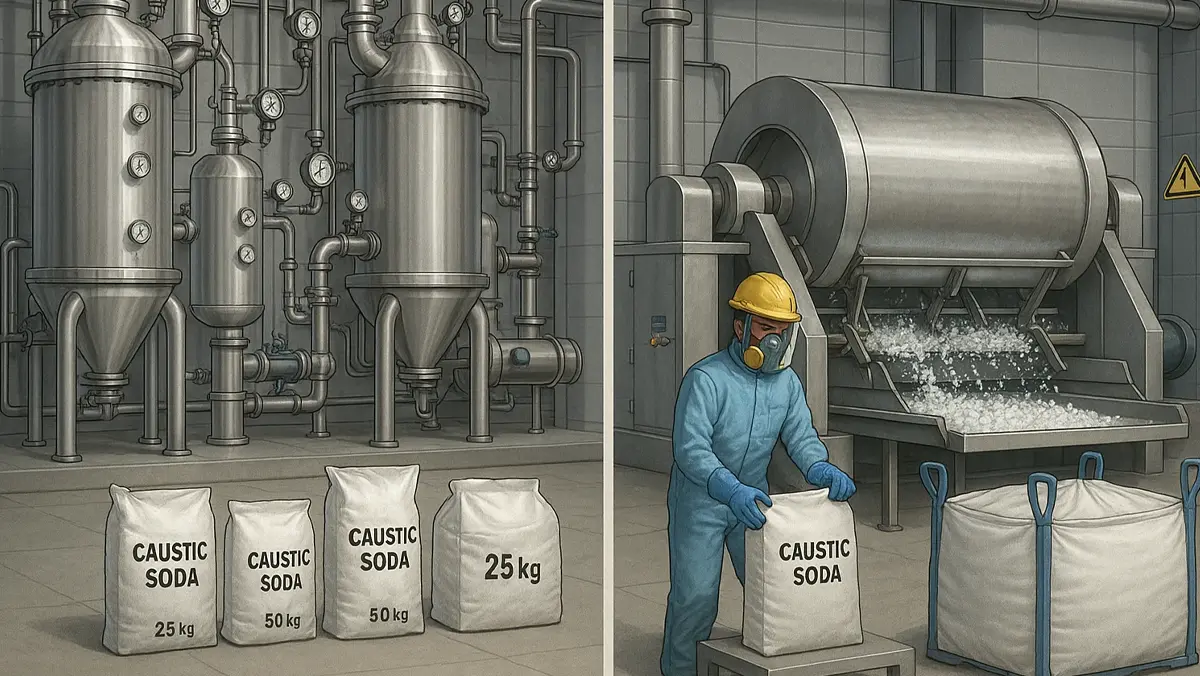
Step 1: Concentration and Evaporation
The produced sodium hydroxide solution (typically 32–33% NaOH) is first evaporated in multi‑effect evaporators to achieve ~ 50% concentration.
This strong solution is the industrial standard for downstream solidification.
- Equipment: Nickel‑lined evaporators and heat exchangers
- Operating temperature: ≈ 140–150 °C
- Purpose: Remove residual water and salts, achieving high purity and uniform viscosity
Step 2: Solidification and Flake Formation
The concentrated caustic soda melt is transferred to cooling and flaking drums—large rotating cylinders cooled by water or air. As the molten material contacts the drum’s surface, it solidifies immediately into a thin layer, which is then scraped off into flakes.
| Stage | Description | Typical Output |
|---|---|---|
| Molten Feed Input | 50% NaOH liquid fed to flaker drum | Uniform molten stream |
| Surface Cooling | Immediate solidification at < 60 °C | Thin solid layer |
| Scraping & Discharge | Rotary blades remove flakes continuously | NaOH flakes (2–5 mm size) |
| Packaging | Bagging into 25 kg or 50 kg HDPE bags | Safe moisture‑proof packaging |
Key Quality Parameters
| Parameter | Typical Value | Importance |
|---|---|---|
| Purity (%) | ≥ 99 % NaOH | Industrial grade standard |
| NaCl Impurity | < 0.1 % (membrane grade) | Ensures high efficiency in chemical reactions |
| Fe Content | < 0.002 % | Prevents coloration and side reactions |
| Moisture | < 0.5 % | Long shelf life and stability |
| Flake Size | 2–5 mm | Uniform dissolution and easy handling |
Industrial Packaging Standard
Finished caustic soda flakes are usually sealed in:
- 25 kg and 50 kg HDPE bags, with double inner liners to resist humidity.
- Optional 1 metric ton bulk bags for heavy industrial buyers.
Packaging standards comply with ISO 909‑1998 and ASTM D2127‑16 quality control certification.
Product Specifications and Chemical Properties
After the flaking stage is completed, caustic soda flakes are graded and tested according to strict industrial standards. The product’s purity and stability define its usability for different applications — from basic chemical processing to high‑purity membrane industries.
1. Chemical Composition and Purity
Caustic soda flakes are almost pure sodium hydroxide (NaOH), typically reaching ≥ 99.0% purity. The remaining fraction usually consists of trace levels of sodium chloride (NaCl) and iron (Fe) due to production equipment.
| Parameter | Typical Value (w/w) |
|---|---|
| NaOH | ≥ 99.0% |
| NaCl | ≤ 0.05% |
| Fe (ppm) | ≤ 10 |
| Moisture | ≤ 0.3% |
| Carbonate (Na₂CO₃) | ≤ 0.5% |
2. Physical Characteristics
- Appearance: White, solid flakes with a smooth surface.
- Odor: Odorless.
- Melting Point: Around 318–323 °C.
- Density: Approximately 2.1 g/cm³.
- Hygroscopic Nature: Strong tendency to absorb moisture and carbon dioxide from air, hence must be stored in sealed containers.
3. Product Grades
Caustic soda flakes are sold in three standard purity grades:
| Grade | Description | Key Applications |
|---|---|---|
| Industrial Grade | Standard purity; used in textiles, paper, and detergents. | Wide industrial use. |
| Membrane Grade | High purity (< 100 ppm NaCl). | Water treatment, pharmaceuticals, high‑purity chemicals. |
| Laboratory Grade | Analytical reagent premium quality. | Research and precision chemistry. |
4. Storage Durability
If kept dry, caustic soda flakes remain chemically stable for up to 24 months. Exposure to air may form a thin layer of sodium carbonate, reducing effective alkalinity but not causing safety issues.
High purity (≥ 99%) and strong alkalinity make caustic soda flakes ideal for chemical synthesis and industrial formulations where reliability and stability are crucial. Accurate storage ensures purity is maintained over time.
Applications and Usage in Industries
Caustic soda flakes are one of the most versatile chemical materials on earth. Their high alkalinity and reactivity make them essential across dozens of industries—from heavy chemical manufacturing to daily consumer products. Below are the major application categories.
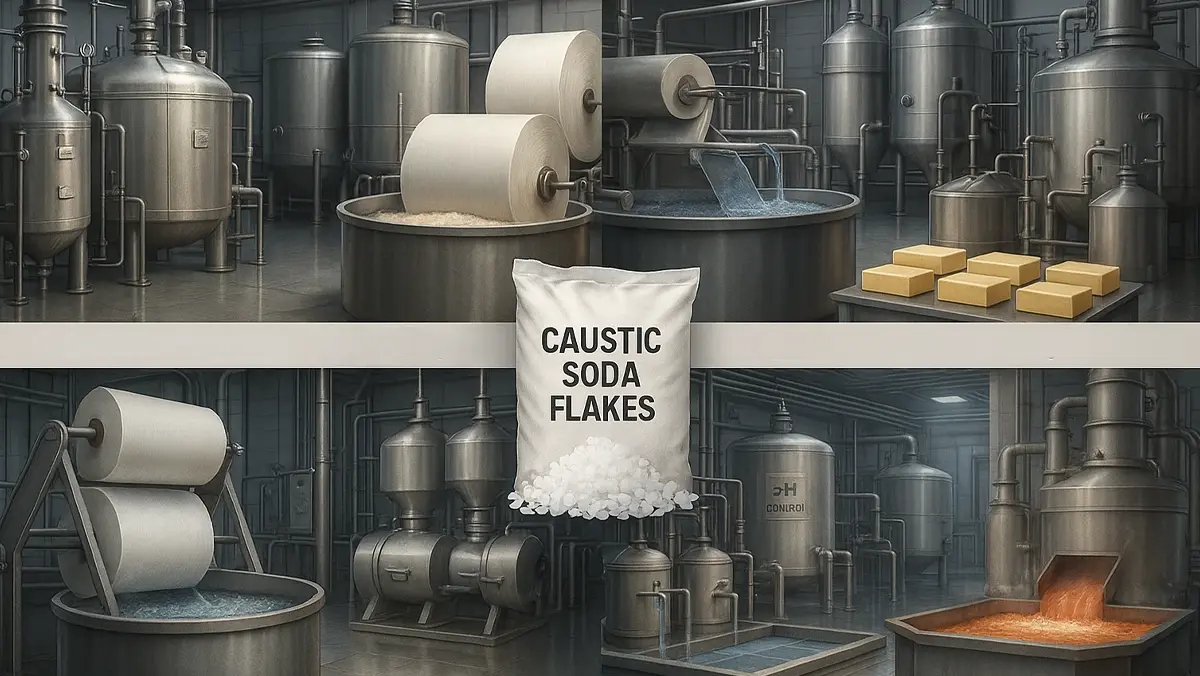
1. Chemical Manufacturing
- Used as a key reactant in producing organic and inorganic chemicals such as sodium hypochlorite, sodium phenolate, and sodium carbonate.
- Acts as a neutralizing agent in acid‑based reactions and stabilizer in chemical synthesis.
2. Pulp and Paper Industry
- Essential for cellulose extraction from wood pulp.
- Breaks down lignin during the Kraft process, giving paper strength and clean whiteness.
- Combined use with sodium sulfide improves processing efficiency.
3. Textile and Dye Industry
- Used to mercerize cotton fibers — increasing their softness and dye absorption.
- Serves as a cleaner for removing natural wax and impurities before dyeing.
- Helps stabilize colors and ensure consistent fabric quality.
4. Soap and Detergent Production
- Reacts with fats and oils (saponification) to produce solid soap.
- Adjusts pH in detergent formulas to ensure proper cleaning strength.
- Its high alkalinity provides desired hardness in bar soaps and effective grease removal.
5. Water Treatment
- Used for pH adjustment and neutralization of acidic wastewater.
- Helps control metal ion concentrations and reduce heavy metal contamination.
- Ensures balanced alkalinity for safe industrial water recycling.
6. Aluminum and Metal Processing
- Employed in refining bauxite to produce alumina (intermediate for aluminum metal).
- Functions as an etching and cleaning agent for steel and other metal surfaces.
Application Purity Guidelines
| Industry | Recommended Purity (%) | Typical Grade |
|---|---|---|
| Pulp/Paper | ≥ 98.5 | Industrial |
| Soap/Detergent | ≥ 99.0 | Industrial |
| Textile | ≥ 99.0 | Membrane |
| Water Treatment | ≥ 99.0 | Membrane |
| Metal Processing | ≥ 99.0 | Industrial/Membrane |
Across all industries, caustic soda flakes serve as a core alkalizing agent that increases efficiency, purity, and reaction stability. Their strong chemical performance makes them indispensable to the global manufacturing ecosystem.
Safety Handling and Storage Guidelines
Because caustic soda flakes are a highly corrosive alkaline material, safe handling and proper storage are essential. Direct contact can cause severe skin and eye burns. It also reacts violently with acids and some metals, releasing heat and hydrogen gas.
1. Hazards
- Corrosiveness: Strong base; reacts with moisture forming heat and caustic solutions.
- Contact Risk: Serious burns on skin and eyes, respiratory irritation if inhaled.
- Environmental Impact: Can damage aquatic life if spilled into waterways.
UN Number: 1823
Hazard Class: 8 (Corrosive)
Packing Group: II
2. Personal Protective Equipment (PPE)
Workers should always use:
- Safety goggles or face shield
- Rubber gloves and long‑sleeved chemical‑resistant outfits
- Respiratory protection when handling dust
- Safety boots resistant to caustic materials
3. Handling Practices
- Avoid contact with water when opening containers to prevent heat release.
- Do not mix with acids, ammonium salts, or aluminum parts.
- Handle in well‑ventilated areas.
- Use dedicated tools and equipment resistant to alkalis.
4. Storage Requirements
- Keep containers tightly closed in a cool, dry, ventilated place.
- Protect from humidity and direct sunlight.
- Use HDPE bags or lined steel drums.
- Store away from acids, organic materials, and oxidizers.
- Maintain indoor temperature below 35 °C to prevent moisture absorption and agglomeration.
5. Emergency Measures
- Skin Contact: Rinse immediately with plenty of water for ≥ 15 minutes.
- Eye Contact: Flush eyes thoroughly and seek medical attention.
- Spillage: Collect dry material carefully; dissolve and neutralize with weak acid (under supervision).
- Fire Safety: Non‑flammable, but reacts with certain metals releasing hydrogen gas – avoid ignition sources.
Safe use of caustic soda flakes depends on protective gear and controlled dry conditions. Following international transport and storage standards (UN 1823, Class 8) ensures personnel safety and prevents environmental contamination.
Packaging and Logistics Standards
Efficient packaging and logistics are critical to preserving the quality and reactivity of caustic soda flakes during storage and transport. Strict compliance with material and labeling standards ensures product safety, purity, and international shipping compatibility.
1. Packaging Specifications
| Parameter | Standard Detail | Purpose |
|---|---|---|
| Primary Container | High‑density polyethylene (HDPE) bag | Provides chemical resistance and moisture protection |
| Inner Liner | Double poly film, heat‑sealed | Prevents air and CO₂ contact |
| Weight Options | 25 kg & 50 kg bag formats (Retail and Industrial) | Fits local distribution and bulk orders |
| Bulk Package | 1 MT jumbo bag (FIBC) with PE inner coating | For long‑distance container shipping |
| Marking and Labeling | Product name, purity, batch number, UN 1823 hazard symbol | Ensures traceability and regulation compliance |
| Sealing Method | Heat‑sealing or multi‑fold stitching | Secure closure against moisture |
2. Handling and Loading Recommendation
| Stage | Guideline | Reason |
|---|---|---|
| Forklift Handling | Always lift from base pallet area; avoid piercing bags | Prevents leakage and chemical exposure |
| Container Lining | Use plastic sheet liner inside container floor | Stops flake contamination or wet spots |
| Stack Arrangement | Two‑layer maximum with cross stack pattern | Avoids compression damage |
| Shipping Mode | Covered truck / closed ship hold | Protection from rain and sun radiation |
| Inspection Point | Check for bag integrity and expiration date before dispatch | Ensures quality and minimizes returns |
3. Labeling and Transport Compliance
Compliance must follow UN, ADR, and IMDG codes for corrosive substances.
| Label Type | Symbol | Regulation |
|---|---|---|
| GHS 05 – Corrosive | Black‑and‑white test tube symbol over hand and metal | Globally Harmonized System |
| UN Number | 1823 – Sodium Hydroxide, Solid | Identifies transport danger class |
| Hazard Class | 8 (Corrosive Substance) | Indicates required protective measures |
| Packing Group | II | Medium‑risk classification for transport |
| Proper Shipping Name | “Caustic Soda Flakes (Sodium Hydroxide, Solid)” | Mandatory document entry |
4. Global Logistics Notes
- Origin Regions: Major manufacturers in China, India, Saudi Arabia, and Iran.
- Common Export Routes: SEA – Middle East to Asia Pacific and Africa.
- Container Type: 20 ft standard dry container (approx. 21 MT net load).
- Moisture Risk Control: Include silica gel bags (about 200 g each) inside bulk packages.
- Documentation: Safety Data Sheet (SDS), Certificate of Analysis (COA), and Packing List must accompany each shipment.
Effective packaging and logistics minimize contamination risks and preserve industrial-grade purity for caustic soda flakes, ensuring safe arrival and compliant global distribution.
Global Market Overview and 2025 Trends
Caustic soda flakes are a globally traded chemical with a strong industrial foundation. Their market size and export flows reflect rapid growth in water treatment, paper, alumina, and chemical sectors.
Key Global Trends (2025)
- Market Volume:Global demand is estimated to reach almost 68 million metric tons in 2025.
- Regional Share:The Asia-Pacific region leads with approximately 64% of production and consumption, driven mainly by China and India.
- Growth Drivers:Key sectors fueling demand include water treatment, alumina refining, and the transition to membrane-based production technology.
- Pricing:Spot prices for caustic soda flakes (FOB Asia) are forecast to be about $520–540 per metric ton in Q2 2025.
- Outlook to 2030:Industry CAGR is expected to remain close to 3.3%, pushing global demand beyond 79 million tons by 2030.
Competitive Insights
- Membrane cell technology now produces the vast majority of high-purity flakes, further improving export quality.
- Major producers: China, USA, Germany, South Korea, and Iran supply big global volumes.
- Exporters focus on stable quality and strict packaging standards for overseas markets.
The caustic soda flakes market continues to grow steadily, powered by changing industrial standards and environmental policies. The shift to sustainable, high-purity production makes this sector competitive and economically reliable for the coming years.
Environmental Impact & Competitive Outlook
1. Environmental Impact
The production and use of caustic soda flakes carry environmental considerations that manufacturers must address.
- Energy Use: Brine electrolysis is energy‑intensive; modern membrane cells reduce energy consumption by up to 25% compared to older processes.
- By‑products: Chlorine and hydrogen require strict handling to prevent toxic releases.
- Waste Control: Improper disposal can raise pH levels in water bodies, harming aquatic life.
- Sustainability Measures: Adoption of closed‑loop brine systems, improved evaporation efficiency, and recyclable packaging (HDPE and FIBC) help reduce environmental footprint.
2. Global Competitive Outlook
- Technology Leader: Membrane cell technology provides cost advantage and higher purity, making producers who upgrade more competitive.
- Regional Strength: APAC dominates in volume; Western Europe and North America focus on high‑purity membrane grades for specialty markets.
- Trade Positioning: Export competitiveness depends on consistent purity, compliance with Class 8 shipping codes, and price stability.
- Market Trend: By 2030, demand for high‑purity flakes will grow faster than for standard grades due to stricter environmental and product quality regulations.
3. Key Success Factors for Producers
- Maintain ≥ 99.0% NaOH purity.
- Ensure packaging and labeling meet ADR/IMDG standards.
- Invest in energy‑efficient production lines.
- Offer flexible logistics solutions for both bulk and small‑pack clients.
Environmental responsibility and technological upgrades will determine which producers remain competitive in the caustic soda flakes market over the next five years. Companies prioritizing sustainable, high‑purity production will secure stronger positions globally.
Conclusion
Caustic soda flakes remain one of the most important base chemicals in the global industrial supply chain. Their key strengths — strong alkalinity, high purity, and versatile application — ensure continued demand across pulp and paper, textiles, detergents, water treatment, aluminum refining, and chemical manufacturing.
The shift toward membrane cell technology has improved quality, reduced energy consumption, and minimized environmental impact. Producers aiming for competitiveness in 2025–2030 must focus on sustainable practices, consistent purity, safe packaging, and compliance with global transport standards.


